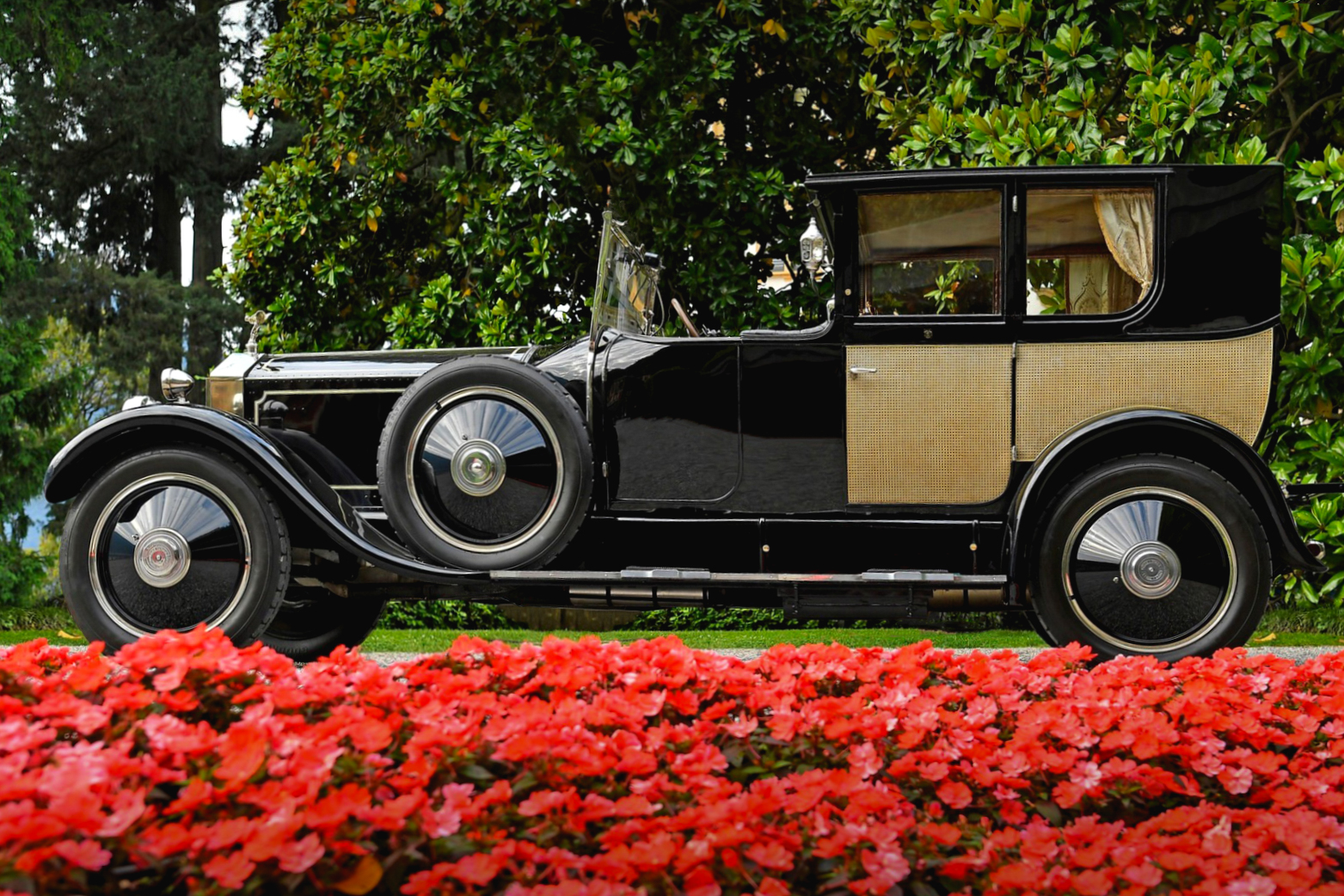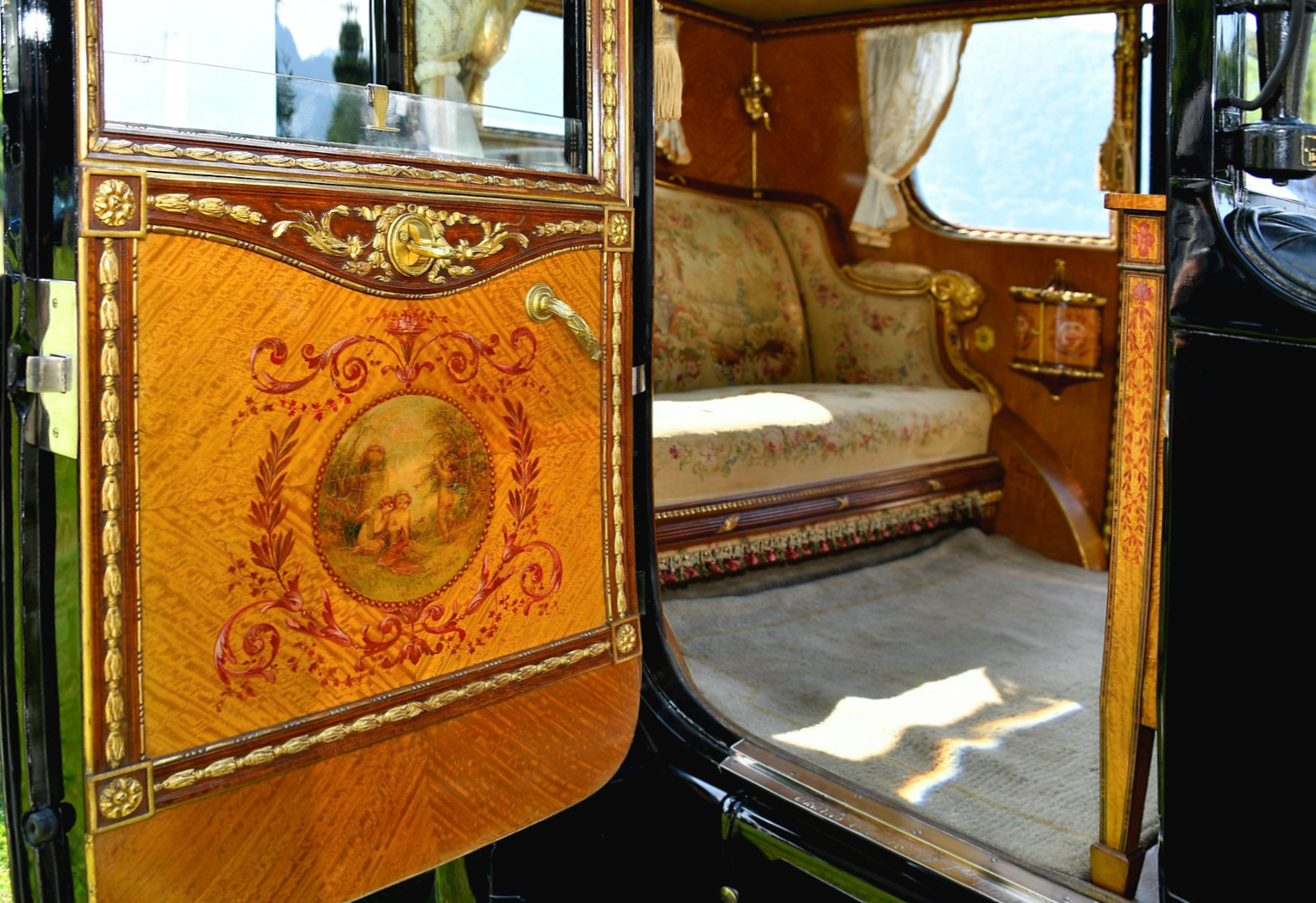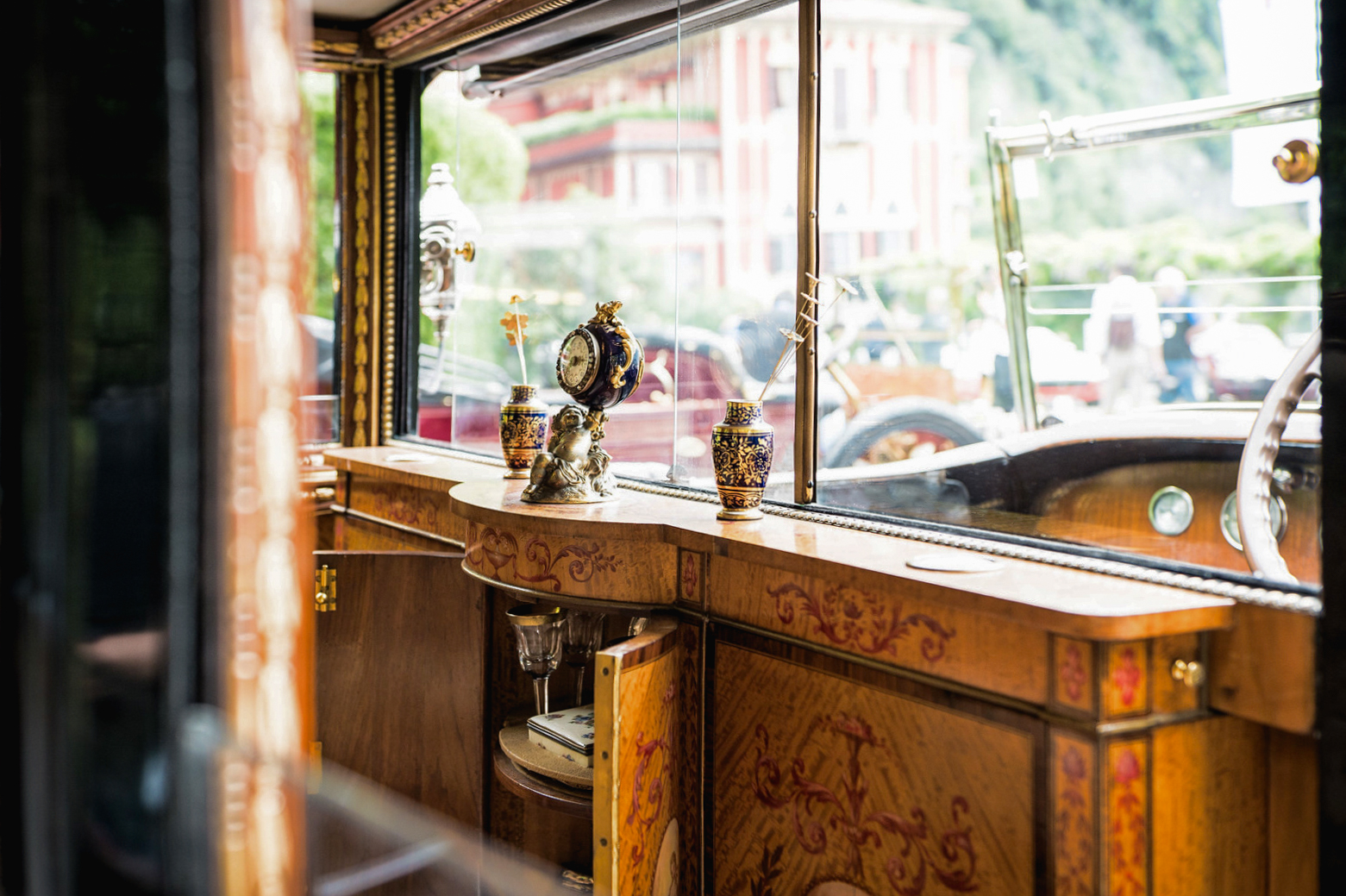
The great coachbuilders paid as much attention to the interior as the exterior of the cars they created. Among the key elements were the instrument dials, which frequently transcended merely displaying essential information to become miniature works of art in their own right.
In 1926, the 40/50HP Phantom I Brougham De Ville, known as ‘The Phantom Of Love’, was built by Charles Clark & Son Ltd of Wolverhampton for Clarence Warren Gasque, an American businessman of French ancestry living in London, as a gift for his heiress wife, Maude. Gasque commissioned an interior to recreate the Rococo ambience of a salon in the Palace of Versailles, with polished satinwood veneer panelling, Aubusson tapestries and a painted ceiling inspired by a sedan chair owned by Marie Antoinette. It also included this remarkable French Ormolu clock, mounted on the partition between the front and rear cabins – an extraordinary detail that represents the pinnacle of the instrument maker’s art.


ROLLS-ROYCE COACHBUILD: A GLORIOUS LEGACY
INTRODUCTION
Coachbuilding is the art and science of creating bespoke bodywork on a pre-assembled chassis. It is as old as the motor car itself. All but extinguished by mass production, coachbuilding nonetheless lives on with Rolls-Royce at the forefront of its rejuvenation.
Drawing on more than a century of experience, and its unique Bespoke capabilities developed in the modern era, the marque has defined a new coachbuilding movement. Long accustomed to being able to commission every aspect of their motor cars’ appearance and specification, Rolls-Royce clients are increasingly seeking opportunities to reach beyond Bespoke and determine the motor car’s physical form.
Ahead of an official statement to be made imminently, we invite media to reflect on the marque’s rich coachbuilding heritage.
THE GENESIS OF COACHBUILDING
When Charles Rolls and Henry Royce first met in 1904, there were only around 8,000 registered motor cars in Great Britain, compared with around half a million horse-drawn vehicles. Yet within 20 years, the carriages and coaches that had ruled the roads unchallenged for more than a century had all but vanished. No longer a novelty or a plaything for the wealthy, the motor car ascended to become the universal means of private travel.
In those early days, car manufacturers generally produced only the mechanical components: a ‘rolling chassis’ was sent to specialist coachbuilders, who then added bodywork to the client’s specification. Some coachbuilders had simply switched from making horse-drawn vehicles; others had begun capitalising on the new opportunities the motor car presented.
These pre-Edwardian car bodies were built in much the same way as their horse-drawn predecessors had been. It quickly became apparent that materials and methods perfectly suited to the pace of horses were less amenable to the hitherto undreamt-of speeds of 30 to 40 miles per hour now attained by the motor car. The art of coachbuilding would have to become altogether more scientific.
COACHBUILDING AND ROLLS-ROYCE: A BRIEF HISTORY
As the 1920s dawned, mass-market car makers were bringing coachbuilding in-house, where engineers could address new issues presented by automotive use such as vibration and torsional stress.
Luxury marques like Rolls-Royce, however, continued to outsource coachwork to specialist houses for several more decades. A Rolls-Royce customer could still have a rolling chassis delivered to their chosen coachbuilder, who would design and build a car body to the client’s specific requirements – similar to ordering a suit from a Savile Row tailor, or a dress from a Paris couturier.
Until the 1930s, most coachbuilders remained true to long-established practice, which involved assembling a wooden frame, usually in ash, onto which aluminium or steel body panels were either pinned or welded. This allowed almost any shape to be created, with designs based around the interior space and fittings requested by the customer. As their experience grew, materials improved and motor cars’ speeds increased, coachbuilders adapted their methods, with later frames made from metal tubing or angle-iron.
This essentially traditional form of coachbuilding continued until the separate chassis was replaced by semi-monocoque construction, with sub-frames for the mechanical components. This process made all but the simplest of adaptations to the body design itself impossible. In the case of Rolls-Royce, this shift occurred in October 1965, when the Silver Cloud series was replaced by the Silver Shadow.
Contrary to popular belief, however, this did not mark the end of coachbuilding at Rolls-Royce. The Phantom VI, built on a separate chassis, remained in production, albeit in small numbers, until 1993, with coachwork supplied by Rolls-Royce subsidiary H. J. Mulliner, Park Ward Ltd.
SOVEREIGNTY OF DESIGN
Although in theory a coachbuilt Rolls-Royce could be any shape the customer desired, in practice there were constraints. Rolls-Royce motor cars were designed on proven technical principles that were, in the minds of the Company’s founders, unarguable and inviolable. By insisting on fixed dimensions for the bulkhead behind the radiator, they were able to ensure the bodywork maintained the essential proportions that visually identified it as a ‘true’ Rolls‑Royce.
Those proportions remain enshrined in the marque’s design tenets to this day. Examine any contemporary Rolls-Royce and it exhibits the 2:1 ratio of body height to wheel diameter first established with the Silver Ghost in 1907. The body shape is defined by three fluid lines running the length of the car: the ‘waft line’ that gives the car its sense of movement; the ‘waist line’ that lends it purpose and presence; and the silhouette, which expresses its individual character.
These basic principals allow considerable scope, as evidenced by the highly distinctive forms of Phantom, Ghost, Wraith, Dawn and Cullinan. Patrons and designers therefore enjoy considerable creative freedom in a coachbuilding project, within these fundamental design parameters. It will, after all, bear the Spirit of Ecstasy figurine above the grille – another immutable principle – so must be a genuine Rolls‑Royce worthy of the name, and recognisably so.
COACHBUILDING AT THE HOME OF ROLLS-ROYCE
Bespoke IS Rolls-Royce and has been central to the marque’s offering and experience since production began at Goodwood in 2003. It has proved phenomenally successful, with commissions increasing year-on-year. The first quarter of 2021 saw the landmark moment when, for the first time, every single motor car built at the Home of Rolls-Royce, across the entire model family, included Bespoke elements. It is the unique vision and capabilities of the Bespoke Collective that makes Rolls-Royce a true luxury house, not merely an automotive manufacturer.
Patrons have always been able to personalise their motor car’s appearance in myriad different ways – beginning with a choice of 44,000 paint colours. But their options for altering its overall outline have historically been limited by the underlying structure. For this reason, fully coachbuilt Rolls-Royce motor cars have been rarities in the modern era; much of the sensation around Sweptail arose precisely because it was such a unique event.
It was made possible by a seismic change in the marque’s manufacturing process, which was first deployed to magnificent effect, and global acclaim, in the eighth-generation incarnation of its pinnacle product, Phantom.
THE FOUNDATION OF A MODERN COACHBUILDING MOVEMENT
The current Phantom was the first car to be built on the marque’s proprietary structure. This is an all-aluminium spaceframe chassis, designed and engineered from the ground up to be scalable for a range of different Rolls-Royce models. In essence, it creates four fixed points at each corner of the motor car. The distance between them can be whatever the designers and engineers want it to be: bulkhead, floor, crossmember and sill panels can all be stretched or shrunk or increased in height according to the product. The concept has proved brilliantly successful, forming the basis for the Cullinan SUV launched in 2019, and in 2020, the new Ghost.
Crucially, this flexibility opens up new possibilities for coachbuilding. By moving away from monocoque construction to something closer to a traditional rolling chassis, Rolls-Royce has reacquired the freedom to construct almost any body shape its patrons can imagine, constrained only by fundamental design and engineering requirements.
This means that Rolls-Royce and its patrons can now look beyond Bespoke and build the car itself, to commission. In this way, it is perfectly aligned with a lifestyle in which the client’s investments in luxury, from property, clothing and jewellery to works of art, yachts or private aircraft are personal, individual and unique.
With the Architecture of Luxury, the marque has ushered in a new coachbuilding movement that encompasses both highly sophisticated 21st Century technology and materials, and a tradition extending back more than 100 years. It is both evolutionary and revolutionary.

You must be logged in to post a comment.